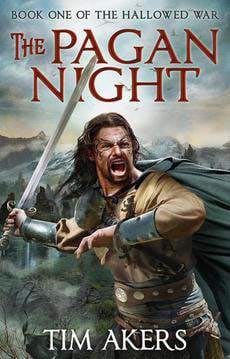
To celebrate the upcoming publication of fantasy novel The Pagan Night, author Tim Akers discusses how pagan symbolism is alive and present in modern Christianity.
* * *
Every book has a seed, some bit of history or mythology that catches the writer’s attention and settles into the deep mulch of their brain, slowly growing into a new world filled with made up people and the stories that they tell. For The Pagan Night, there were two seeds. The first was the slow cultural integration of the Angles and the Saxons following the Conquest. That kind of generations-long car crash has always fascinated me, and tracing the wreckage in our modern times is kind of a hobby of mine.
Related to that, and in a lot of ways more dominant in the actual book, is the religious integration of paganism into early Christianity. This was done more intentionally, either due to the stubbornness of converts or the wile of priests, but its wreckage is just as thoroughly hidden from the modern eye. The absorption of pagan symbolism is so complete that most Christians are completely unaware it even exists.
The simplest and most obvious changes are the adoption of pagan holidays into the Christian calendar. Christmas, Easter, All Hallow’s Eve and St. John’s Day all align with pagan holy days. The name Easter might even come from Oester, a Germanic fertility goddess whose feast was observed with rabbits, eggs and beans. Easter is doubly tricky because it’s the one date that Christians can accurately trace. It’s unquestionably the earliest and most Christian of the holidays, so the fact that even it has adopted pagan practices says a lot about the way the early religion adapted to local rituals.
This method of appropriating extant pagan ritual and incorporating it into Christian worship goes beyond holidays. The Catholic practice of praying for the intercession of the saints traces its origin to early missionaries rebranding the local pagan god or goddess as St. Michael or St. Bart or whomever, incorporating the god’s symbolism into the icons of the chosen saint and moving on. There’s even one saint, St. Brigid, who is simply a converted goddess. Brigid was a river spirit whose symbol happened to be a cross of reeds. Super convenient. Only a fool wouldn’t seize an opportunity like that. The use of crosses as religious symbols predates Christianity in Ireland, another fortunate happenstance that made the business of early missionaries all the easier.
Christmas has been similarly corrupted. There are elements of the Roman holiday Saturnalia, which was a winter festival celebrating the rebirth of the sun and involved gift-giving and candles, in the modern holiday. Yuletide celebrations descend from Viking lore, and the hanging of wreaths and decorating of trees is about as druidic as you can get. Martin Luther protested the practice of Christmas trees, quite a difference from the modern concerns about the war on Christmas here in the States.
The theology of the afterlife is tricky, and something that has evolved over the course of time. Judaism has no concept of the afterlife, and when Christ speaks of the wages of sin he refers to a physical place in Jerusalem, Sheol, not hell as it’s currently translated in English. Even the word hell comes from Norse mythology. Hel was both the name of a ruler of the underworld and the realm that she ruled. In Norse poetry of the time, “go to Hel” simply meant to die, a concept that has become linked to damnation in the modern lexicon.
By its nature, religion and culture are always locked in a cycle of evolution. Our myths inform our beliefs, and our beliefs inform our world. Tracing the history of those beliefs, sifting through the strata of time to find artifacts of ancient practice, even rediscovering a way of belief that has lain fallow for centuries, all of these things can only enrich our lives. It’s especially valuable at a time when the mythology of monoculture has taken over so much of the public debate. Every church is built of very old stones, sacred in their own right, and worthy of our memory.
* * *
From an exciting new voice in epic fantasy comes the beginning of a trilogy ten years in the making… THE PAGAN NIGHT by Tim Akers, to be published on 19th January 2016 by Titan Books in paperback and ebook format.
Ruling with an iron hand, the Church has eliminated the ancient pagan ways. Yet demonic gheists terrorize the land, hunted by the Inquisition, while age-old hatreds rage between the north and the south. Three heroes—Malcolm Blakekey, his son Ian, and Gwendolyn Adair—must end the bloodshed before unstoppable chaos is unleashed. Yet powerful forces oppose them from all sides, and it’s all but impossible to tell friend from foe.
The Pagan Night thrusts a diverse cast of heroic fantasy characters into a world torn apart by magic and politics, where warring factions vie for power. The perfect addition to the fantasy landscape currently enjoying a renaissance thanks to modern masters such as Brandon Sanderson, George R. R. Martin and Robin Hobb, The Pagan Night is a contemporary classic in the making.
Tim Akers was born in deeply rural North Carolina, the only son of a theologian. He is the author of the Burn Cycle by Solaris Books, as well as The Horns of Ruin, featuring Eva Forge, published by Pyr Books. Ten years in the making, The Pagan Night is his inaugural entry into epic fantasy.


Be the first to comment